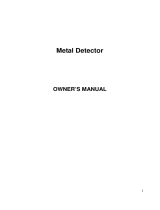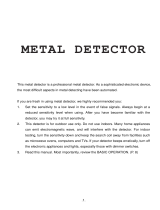
CS300 VELLEMAN
REMARKS:
- In DISC, NOTCH and AUTO NOTCH modes, press ADJ to adjust the sensitivity (SENS). Press + to
increase, press – to decrease.
- Set the sensitivity to a higher lever in order to detect deeply buried targets. Setting the sensitivity to the
maximum level however, will make the detector prone to interference and false signals from aerials and
other electric lines.
- Selection of undesired items as in the NOTCH mode is not available in the AUTO NOTCH mode.
- Ground balance and Ground Trac
®
are not available in DISC, NOTCH and AUTO NOTCH modes.
- Use the surface elimination function (SURF ELIM) in the DISC, NOTCH and AUTO NOTCH modes when
hunting on soils containing lots of metallic trash in order to balance the signal of a relatively large object
and to optimize the detection results. The surface elimination function allows the unit to discriminate deeply
buried objects.
c. Testing and Using the Detector
To learn how the detector reacts to different metals, you should test it before you use it the first time. You can
test the detector indoors and outdoors.
- INDOOR testing and use
NOTE: Never test the detector on a floor inside a building. Most buildings have metal of some kind in the
floor, which might interfere with the objects you’re testing, or mask the signal completely.
1. Slide the POWER switch to ON.
2. Select the operating mode.
3. Place the detector on a wooden or plastic table, and remove any watches, rings or metal jewellery you
are wearing.
4. Adjust the search coil so the flat part points towards the ceiling.
5. In DISC, NOTCH and AUTO NOTCH modes, slowly sweep a sample of the material you want the
detector to find (such as a gold ring or a coin) 2 ~ 3 inches above the face of the search coil. When the
detector detects any metal within the selected range, it sounds a tone and an arrow appears below the
target icon. The LCD displays the depth of the target.
In ALL-METAL mode, hold a sample about one foot above the search coil and slowly sweep the search
coil. When the detector detects the sample, it sounds a tone and the depth will be displayed.
NOTE: if you are using a coin, the detector will detect it more easily if you hold it so that a flat side is
parallel with the flat side of the search coil. A sweep with the side of the coin over the search coil might
cause false indication and unstable display of the arrow.
- OUTDOOR testing and use
1. Slide the POWER switch to ON.
2. Select the operating mode.
3. Find an area on the ground outside where there is no metal.
4. Place the material you want the detector to find (such as a gold ring or a coin) on the ground.
NOTE: If you are using a valuable metal sample such as gold to test the detector, mark the area where
you placed the item, to help you retrieve it later. Do not place it in tall grass or weeds.
5. Hold the search coil level to the ground about 1 ~ 2 inches above the surface, slowly move the search
coil over the area where you placed the sample, sweeping the search coil in a side-to-side motion.
6. If the detector detects the item, it sounds a tone, and an arrow and the depth appear on the display
below the target icon.
7. If the detector does not detect the item, make sure that the target mode is set correctly for the type of
metal you are searching for. Also make sure that you are moving the search coil correctly.
d. Search Coil Sweeping Hints
- Never sweep the search coil as if it were a pendulum. Raising the search coil while sweeping or at the end
of a sweep will cause false readings.









